

Sacher-Torte, a Vienna, Austria, classic since 1832, was created by Franz Sacher for Prince Metternich and has since become a timeless symbol of elegance. The decadent bittersweet chocolate and satisfying apricot filling are a match made in heaven, and a brush of simple syrup ensures moisture and tenderness. Topped with a smooth, glossy glaze that elegantly covers the sides, Sacher-Torte is as visually stunning as it is delicious—a perfect balance of flavors and textures in every bite.
Join us for Baking School with Williams Sonoma on Monday, May 12, 2025, at 5 p.m. PT. Laura Crandall will guide you every step of the way to create a Sacher-Torte so delicious, you’ll want to bake it on repeat. Don’t miss this deliciously rewarding class! Register here.
Click here to download a printable PDF of this lesson!
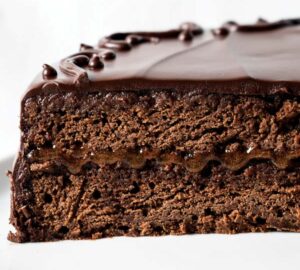
Vienna, with its grand cafés and waltzing rhythm, has long been a city where history is served on a plate. Few dishes speak to the elegance and mystery of this city more than Sacher-Torte, a cake born from a stroke of fate.
In 1832, Austrian State Chancellor Prince Klemens Wenzel von Metternich tasked his kitchen with creating an extraordinary dessert to impress a group of distinguished guests. But as luck would have it, the head chef fell ill that evening, leaving a 16-year-old apprentice, Franz Sacher, to step up to the challenge. With limited ingredients—dark chocolate, butter, eggs, and apricot jam—Franz managed to create what would become one of the most famous cakes in the world: the Sacher-Torte. The cake was so successful, it was deemed “presentable at court,” and its rich, bittersweet chocolate flavor quickly gained a cult following.
But the true magic of Sacher-Torte came later, with Franz’s son, Eduard Sacher. A talented pastry chef in his own right, Eduard refined the recipe when he began serving the cake at the Hotel Sacher, which he established in the heart of Vienna. His version of the cake was elevated, with a richness and balance that made it an unforgettable experience. It was no longer just a cake—it became a celebration of refinement, a true taste of Vienna, and a dessert worthy of its own place in history.
CHOCOLATE CAKE: Soft yet sturdy-crumbed dark chocolate sponge cake layers.
APRICOT PRESERVES: Strained for a silky-smooth texture while preserving its fruit-forward flavor.
CHOCOLATE GLAZE: Shiny and easily spreadable dark chocolate enrobes the entire creation.
Understanding the role of each ingredient ensures your Sacher-Torte will have the perfect texture, flavor, and structure.
EGGS: Eggs bring richness through their yolks and moisture through their whites, but they also help leaven baked goods. This recipe uses four large eggs for the cake batter’s leavening, flavor, richness, and structure.
GRANULATED SUGAR: Granulated sugar does more than add sweetness to the cake. Sugar acts as a stabilizer when whipping the egg whites. Also, sugar has hygroscopic properties, meaning it can absorb water from the surrounding environment to help the cake stay soft and fresh for days after baking.
BITTERSWEET CHOCOLATE: The high cacao content of bittersweet chocolate makes for a deep and less sweet flavor than semisweet or milk chocolate, though it’s sweeter than dark chocolate. Our recipe utilizes bittersweet chocolate in the batter and glaze, creating the perfect chocolaty balance.
UNSALTED BUTTER: Butter brings tender, rich milk fat to cakes and provides a welcome flavor boost. We use unsalted European-style butter, which has a higher fat content than other butter. In the cake batter, unsalted butter lets us control the amount of salt used in this recipe.In the glaze, butter adds a glossy finish, guarantees smooth emulsification, and enriches the texture, contributing to the creamy consistency.
SOUR CREAM: Sour cream adds a slight tang, richness, and moisture to the cake batter without thinning it out.
CAKE FLOUR: Because it’s made from a soft wheat, unbleached cake flour makes a more delicate sponge than all-purpose flour, but with a protein content of 5% to 8%, it still provides enough structure for our cake.
BAKING POWDER: Most baking powders are double-acting, meaning the reaction occurs twice, using two different acids. The first is a quick reaction when baking powder is combined with a liquid in the batter. The second reaction is slower, occurring when the cake bakes.
VANILLA EXTRACT: Vanilla adds a rich, aromatic depth to the cake and contributes to a well-rounded, sophisticated taste.
APRICOT PRESERVES: Choose a high- quality apricot spread for the best flavor. For the best texture, we sieve it smooth so it applies evenly to the cake layers.
CORN SYRUP: Corn syrup helps the chocolate glaze stay fluid enough to spread it smooth and pipe it onto the cake as decoration before it fully sets up.
CHOCOLATE SPRINKLES: Simple store-bought chocolate sprinkles add an easy finish to the cake’s edges for a bakery-perfect presentation.
 TOOLS OF THE TRADE
TOOLS OF THE TRADEEssential equipment to make the perfect Sacher-Torte.
Creating a double-boiler by placing a heatproof GLASS BOWL over a SAUCEPAN of simmering water is a slow and steady process for melting chocolate and butter, which ensures the chocolate retains its smooth, glossy texture. The gentle heat prevents the ingredients from scorching; just be sure the bowl doesn’t touch the water. (Pictured: Williams Sonoma Glass Mixing Bowl 10-Piece Set and Williams Sonoma Signature Thermo-Clad Stainless Steel Saucepan)
An OFFSET SPATULA is perfect for smoothing batter into cake pans, spreading apricot preserves, and, of course, applying that gorgeous chocolate glaze. Its angled blade gives you just the right amount of control to spread things evenly, particularly when you’re guiding the warm chocolate glaze onto the layers. (Pictured: Williams Sonoma Olivewood Icing Offset Spatula)
Strain apricot preserves through a FINE-MESH SIEVE to remove solids to create a smooth, even spread. This step is crucial for achieving the silky texture that enhances the cake’s overall flavor and consistency. (Pictured: Williams Sonoma All-Clad Stainless Steel Strainer)
Two 8-inch ROUND CAKE PANS are the perfect size to achieve the height and texture this cake needs. Lining the bottoms with parchment paper is essential—this ensures the layers come out effortlessly without sticking. (Pictured: Williams Sonoma Goldtouch Pro 8-inch Round Cake Pans)
A WIRE RACK allows air to circulate around the cake layers, ensuring they cool evenly and don’t become soggy. Placing the rack on a RIMMED BAKING SHEET helps to catch any glaze drips, keeping your counter clean and making cleanup a breeze. (Pictured: Williams Sonoma Goldtouch Pro Nonstick Non-Corrugated Half Sheet Pan with Cooling Rack)
A PASTRY BRUSH is your not-so-secret weapon to applying simple syrup. Gently brushing the syrup onto the cake layers helps lock in moisture and enhances the flavor without overwhelming the chocolate. (Pictured: Williams Sonoma Classic Pastry Brush)
A CAKE LIFTER is a flat, wide spatula with a long handle that lets you move delicate cake layers with ease. The slim design slides under the cake without damaging it, making it ideal for transferring a cake that’s as precious as this Sacher-Torte. (Pictured: Nordic Ware Cake Lifter)
SILICONE SPATULAS allow for gentle folding of egg whites into the batter without deflating them—key to achieving the perfect light yet rich texture. Their flexibility ensures that every bit of chocolate mixture is incorporated smoothly, preventing streaks of unmixed ingredients. Plus, they’re heat-resistant, making them ideal for stirring the chocolate glaze until it reaches the perfect glossy consistency. (Pictured: GIR Ultimate Spatula and GIR Ultimate Mini Spatula)
Using a sturdy LIQUID-MEASURING CUP with a handle makes pouring the warm chocolate glaze onto the cake effortless. (Pictured: OXO Angled Measuring Cup)
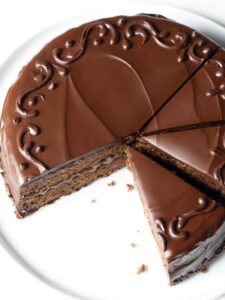
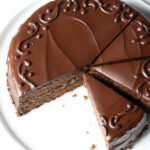
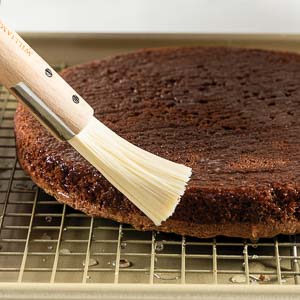
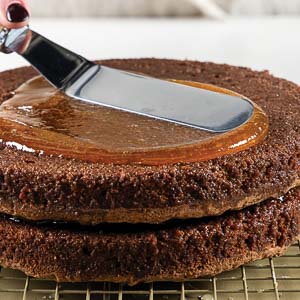
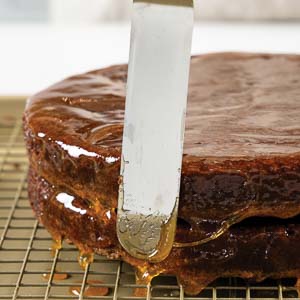
Brushing your cake layers with simple syrup not only adds moisture but also helps the apricot preserves adhere. This simple syrup will keep your cake layers light and tender, adding an extra depth of flavor.
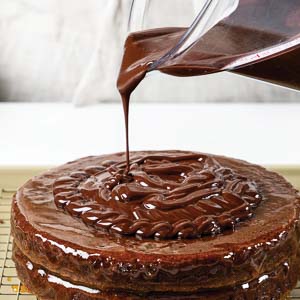
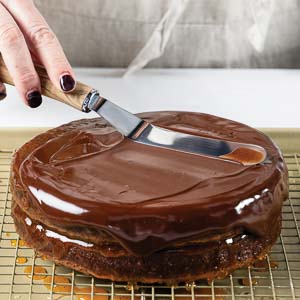
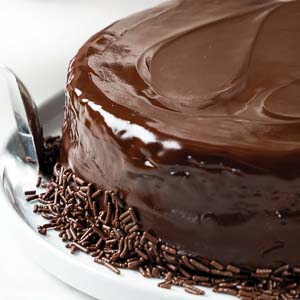
After the glaze has started to set but is still soft enough to cling, add a touch of elegance by adorning the bottom edge of the cake with chocolate sprinkles. This adds texture and a visual contrast to the smooth surface of the glaze.

Pipe a design on top of the cake once the glaze has firmed up a little. A timeless design is a series of filigrees around the edges for a refined look. This is your chance to add a personal touch—whether simple or intricate, it’s the perfect finishing detail.
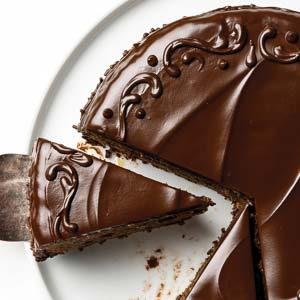
While it may be tempting to cut into your Sacher-Torte right away, give it some time in the fridge to allow the glaze to firm up. This also enhances the flavors and texture, resulting in a perfect slice when you’re ready to serve.
The post Baking School In-Depth: Sacher-Torte first appeared on Bake from Scratch.